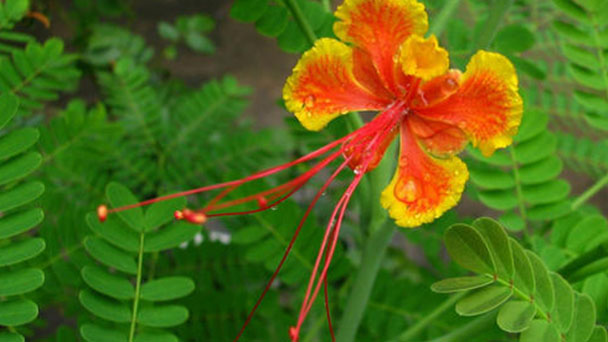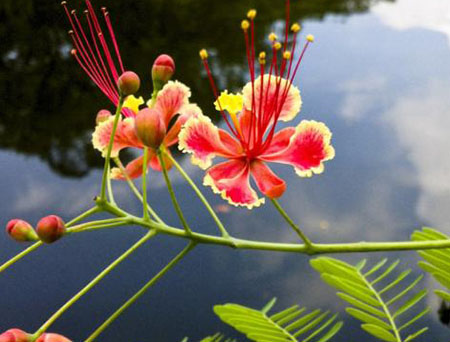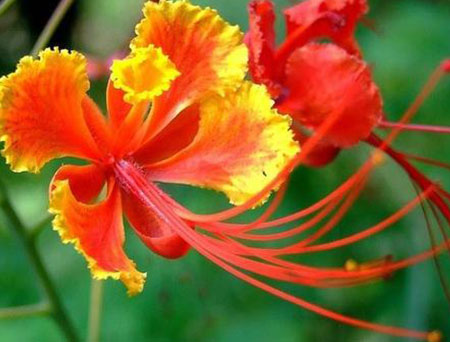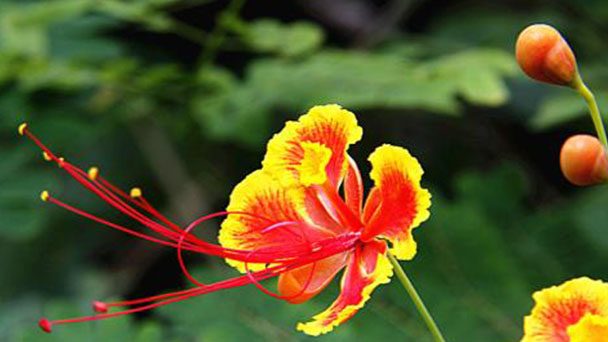Caesalpinia pulcherrima profile
Written by Maggie
Nov 12 2020

Caesalpinia pulcherrima is a common flower in urban greening. Although it is very common, not many people know its name.
Caesalpinia pulcherrima picture
Morphological characteristics
Caesalpinia pulcherrima is a large shrub or small tree, up to 3 meters in height; the branches are green or pink-green with sparse thorns. There are 4 to 8 pairs of bipinnate compound leaves, opposite, 7 to 11 pairs of leaflets, oblong or obovate, skewed at the base, concave at the top, and short petiole. The racemes are terminal or axillary, the petals are round and stalked, orange or yellow, and the peduncle is 7 cm long. The pods are black. There are 6 to 9 seeds. Flower and fruit period is almost all year round.
Growth habits and distribution
Caesalpinia pulcherrima is a tropical tree species. It likes high temperature and high humidity, and has low cold tolerance. In the case of long-term low temperature of 5-8℃, the branches are subject to cold damage and avoid frost. In southern China, Guangzhou, Nanning and other places, it can be safe in open fields in normal years.
Potted Caesalpinia pulcherrima, moved into a greenhouse or indoors in winter, the room temperature should not be lower than 10 ℃, liking light, not tolerant to shade, resistant to hot sun and high temperature, suitable for planting in a sunny place, not harsh on the soil, sandy soil or heavy clay All suitable, like acid soil, more resistant to drought, and slightly resistant to water and humidity.
Casalpinia pulcherrima is native to the West Indies and is cultivated in Yunnan, Guangxi, Guangdong and Taiwan, China. It is one of the valuable ornamental trees in the tropics.

Reproduction method
Caesalpinia pulcherrima is mostly reproduced by seeds. From mid-June to mid-December, the pods mature one after another. The mature pods are collected from September to October. The mature pods are collected and exposed to sunlight. After cracking, the seeds are released. Picking and sowing, the seedlings are cold-proof and overwintering, and the seeds can also be stored for spring sowing the following year. The germination temperature of Caesalpinia pulcherrima seeds should be above 20℃. It is better to sow in mid-to-late March in spring. Soak the seeds with 60℃ warm water before sowing, and continue to soak for 12 hours after cooling. The germination will be rapid. Generally, germination will begin three days after sowing, within a week The germination is over, the germination rate is about 60{bf}.
The other is to use the drill method. Caesalpinia pulcherrima seedlings grow at a moderate rate. Nitrogen fertilizer is applied 2-3 times to top the seedlings during the seedling period. After October, the nitrogen fertilizer is stopped and the potassium fertilizer is applied to promote early lignification. Pay attention to cover and prevent frost in winter. It can be planted out of the nursery, and the 2-year-old young tree can bloom for viewing. If leaf spot disease occurs, use 50{bf} carbendazim wettable powder 500 times to prevent and cure.
Cultivation method of Caesalpinia pulcherrima
Caesalpinia pulcherrima is best planted in sunny terrain and loose fertile soil. It can also grow in poorer soil. Propagate with seeds. Caesalpinia pulcherrima is propagated from seeds. Planting from March to September is most suitable for planting in April, so that it can bloom in early and mid-June and the flowering period can be maintained for more than two months. Before sowing, the seedbed should be drenched to keep it moist. The seeds of Caesalpinia pulcherrima are relatively small and should not be watered immediately after sowing to avoid washing off the seeds. Cover with a layer of about 3-4 mm thin soil, pay attention to shading, and seedlings will emerge after about 10 days. When the seedlings grow 2-3 leaves, they should start transplanting, and then gradually colonize or grow in pots.
Caesalpinia pulcherrima has strong viability, good adaptability, and generally has few pests. If powdery mildew occurs due to high temperature and high humidity, it can be sprayed with 800 times liquid of 50 {bf} thiophanate wettable powder to prevent it. If leaf spot disease occurs, use 50{bf} carbendazim wettable powder 500 times to prevent and cure. The main pest of buttercup is the red hawk moth, whose larvae eat the leaves of impatiens. If this pest is found, it can be manually captured and eliminated.
Caesalpinia pulcherrima main value
Ornamental value
Caesalpinia pulcherrima, Leguminosae is an erect evergreen shrub. With a height of 3 meters, the corolla is orange-red and the edge is golden yellow. It blooms all year round like a flame butterfly. It is one of the valuable ornamental trees in the tropics.
Among the flowers, Caesalpinia pulcherrima does not attract people with color and fragrance, but mainly wins by appearance. The flower shape of Caesalpinia pulcherrima is extraordinarily ingenious. The flower is like a flying phoenix. The flower has heads, tails, wings and feet. It is vivid and vivid, just like a phoenix flying, which makes people have to admire the wonders of nature.
Medicinal value
Caesalpinia pulcherrima is a well-known traditional Chinese medicine. The seeds are used as medicine, which has the effect of promoting blood circulation and promoting menstruation. Squeezing the stem juice with rice wine can treat bruises.
The seeds and the stems can be used as medicine. Fresh grass smashed and applied externally can cure sores, boils, swelling and pain, and poisonous insect bites. Caesalpinia pulcherrima seeds are antidotes. It has the effects of regulating menstruation, inducing labor, expectorating, and eliminating buildup. Pregnant women should not take it; the whole herb is mashed for external use to treat traumatic injuries. The seeds contain saponins, fatty oils, sterols, polysaccharides, proteins, amino acids, and volatile oils. Caesalpinia pulcherrima is cultivated in all provinces in north and south of China; for viewing, it can also be used as cut flowers in addition to flower borders and bonsai devices.
Caesalpinia pulcherrima flower is used as medicine to promote blood circulation and reduce swelling and treat traumatic injuries. Applying outside the flower can cure goose palm madness, but also eliminate body odor; applying outside the seed decoction can cure numbness and soreness. Activating blood circulation, dispelling wind and relieving pain, detoxification for external use. Used for amenorrhea, bruises, blood stasis, swelling pain, rheumatoid arthritis, carbuncle furuncle, snake bite, ringworm of the hand. Modern pharmacological studies have found that Caesalpinia pulcherrima also contains various anthocyanins, which have varying degrees of inhibitory effects on various pathogenic bacteria such as Flavus vulgaris, Pseudomonas aeruginosa and Shigella.
In addition, the Chinese folks often use Caesalpinia pulcherrima flap pressing juice to treat onychomycosis.
Specific method: harvest the blooming petals of Caesalpinia pulcherrima, press the juice, apply on the nail cover, apply 2 to 3 times a day, the onychomycosis will gradually improve. Unused Caesalpinia pulcherrima juice should be bottled, and it can be stored in a refrigerator at 0°C to 5°C for a long time to prevent the temperature from increasing and causing mildew. Pay attention to the treatment of onychomycosis, do not add alum to the juice.
Food seasoning
When people boil meat and stew fish, they put in several Caesalpinia pulcherrima seeds. The meat is easy to rot, and the bones are easy to crisp.

Caesalpinia pulcherrima plant culture
Flower language
Caesalpinia pulcherrima was chosen to be dedicated to Prince Franconian-Saint Clad. When his father died, he was hunted down by the uncle who wanted to seize the throne. In order to escape for his life, he gave up the succession to the throne and became a clergyman. Therefore, the flower language of Caesalpinia pulcherrima is "escape." People who are born with the blessing of this kind of flower language are depressed. Although they are in dances and other occasions, they seem to hide in corners and watch with cold eyes. However, when the loved one appears, his personality may suddenly change. Carry out his belief in love.
legend
A long time ago, religions were willing to associate saints with certain kinds of flowers, so when commemorating them, they would also put flowers in full bloom next to them. Over time, the church will match each day of the year with a flower, and of course there will be a corresponding combination of saints. This is the so-called "flower calendar." And friends who have read the above story must know that it is the flower dedicated to the poor prince above, Caesalpinia pulcherrima. It is said that after he gave up the kingship, he did a lot of good deeds and took care of the poor, so he came to pay homage to him.
Latest Updated
- Benefits of Bugleweed - 7 Science-backed Health Benefits
- Bugleweed Dangers & Side Effects - Is It Poisonous?
- How to Plant Evergreen Trees - What You Should Know
- When to Plant Evergreens - Grow Guide for Evergreen Trees
- 12 Wonderful Evergreen Shrubs for Your Garden
- 12 Popular Evergreen Plants with Pictures for Beginners
- When And How To Prune A Lilac Bush Like a Pro
- How to Grow & Care for Lilac Vine (Hardenbergia Violacea)
- Japanese Lilac Tree (Syringa Reticulata) Care & Propagation Guide
- Shumard Oak Pros and Cons - What to Know
Popular Articles
- Winter maintenance of Antirrhinum Majus
- How to Grow Terminalia Mantaly Tree
- How to Grow and Care for Crossostephium Chinense
- How to grow Antirrhinum Majus in spring
- Peristeria Elata (Dove Orchid) Profile: Info & Care Guide
- Underwatered Snake Plant (Sansevieria Trifasciata) - Signs And How To Fix
- How to Care for Brazilian Jasmine Plant (Mandevilla Sanderi)
- How to Grow & Care for Graptopetalum Purple Delight in Summer
- Rosa Chinensis (China Rose): Plant Growing & Care Tips
- How to Care for Baby Sun Rose (Aptenia Cordifolia)
